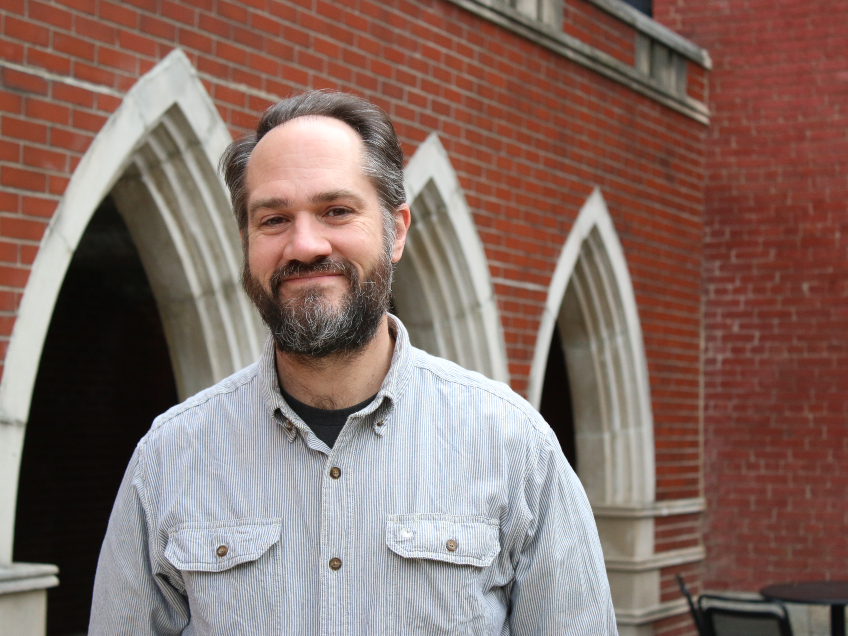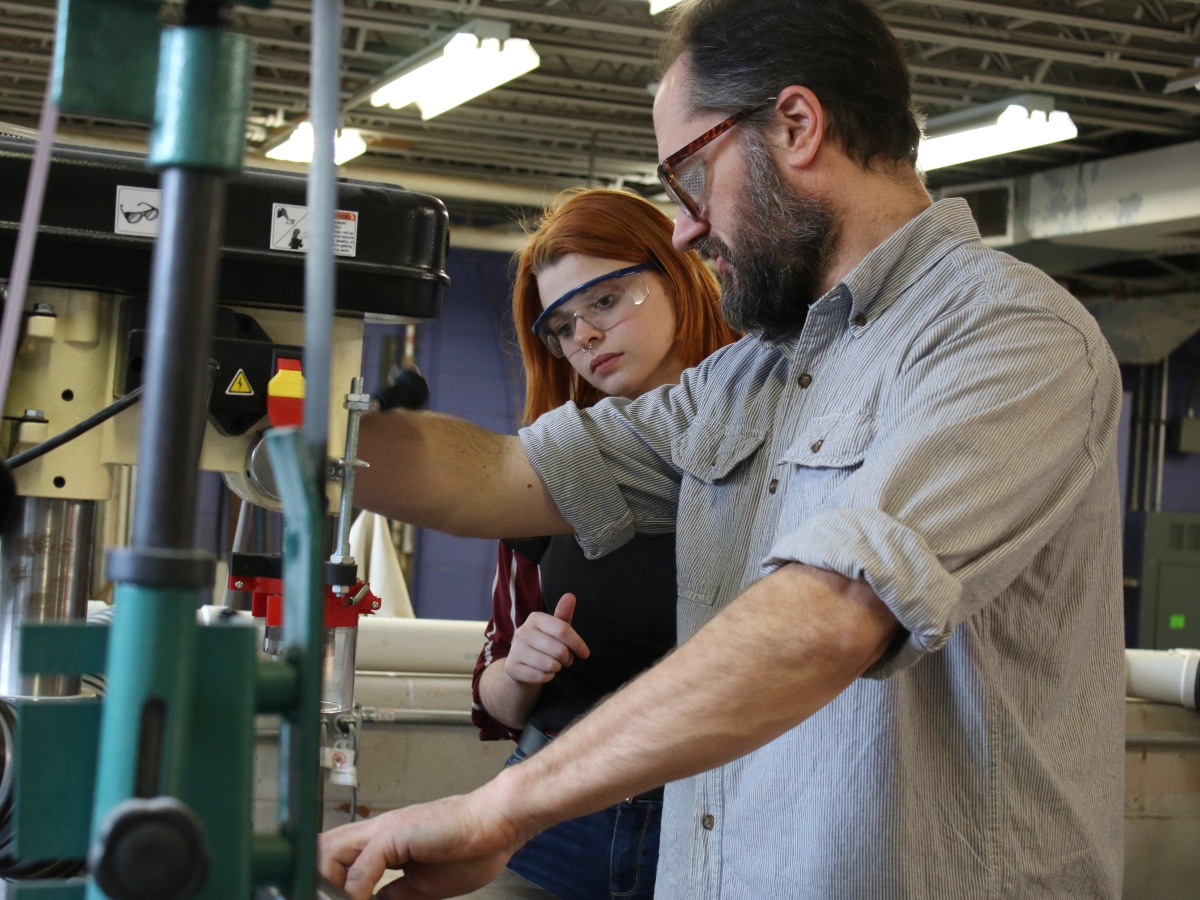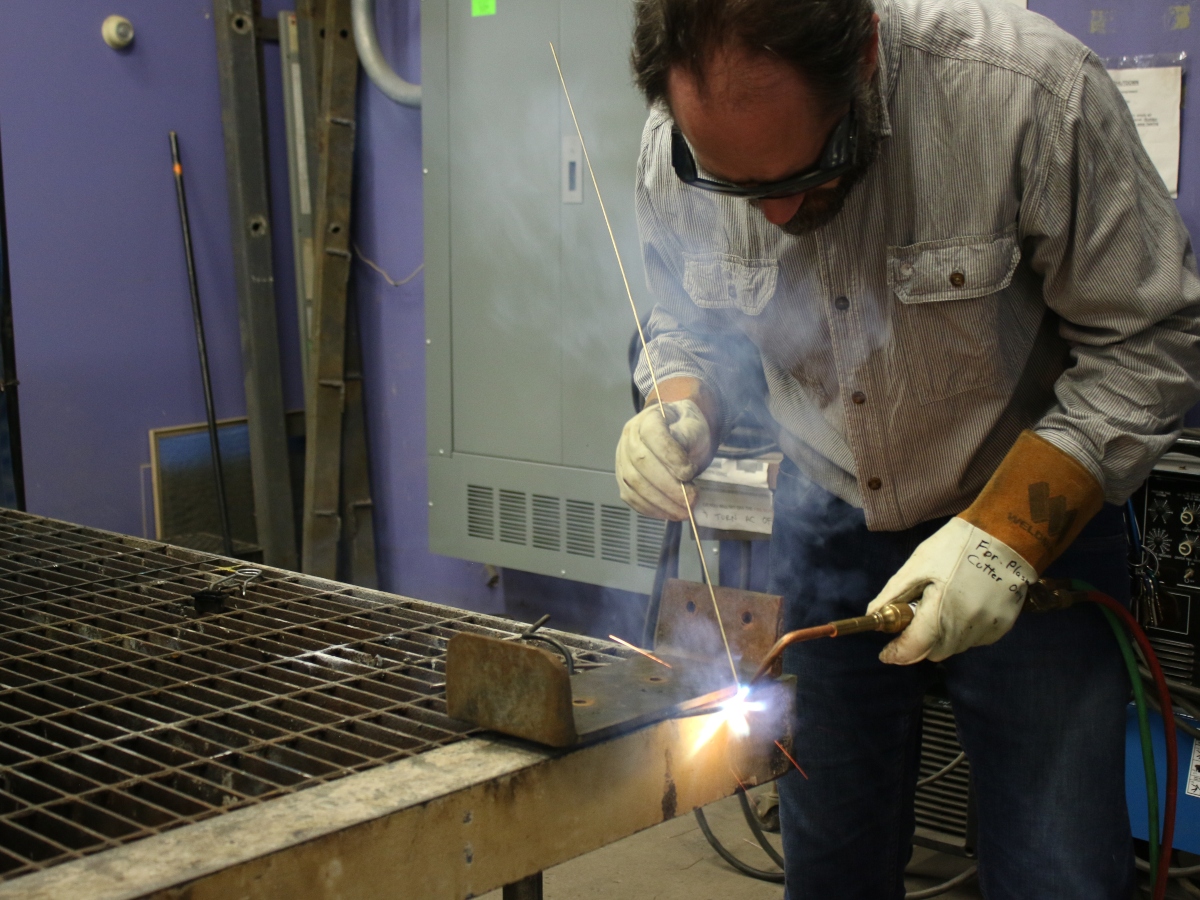
Faculty Focus Friday is a Q&A series that highlights individual faculty members in various academic programs around Spalding University. Today’s featured faculty member is Shawn Hennessey, Assistant Professor of 3D Art and Studio Technician for Spalding’s Creative Arts department (BFA in Studio Art program). He teaches courses and supervises Spalding’s new Makerspace, which features a range of woodworking, metalworking, 3D printing and laser-cutting equipment. Hennessey studied sculpture as an undergraduate at the University of Cincinnati’s College of Design, Architecture, Art and Planning, and he holds a Master of Fine Arts degree in painting and drawing from Ohio State University. Hennessey was an adjunct instructor at Spalding before joining the faculty full-time in 2019. Hennessey and his wife, Nora Christensen, run Squallis Puppeteers, a prominent nonprofit organization that builds puppets and does puppet shows across the community.
What do you like about working and teaching at Spalding?
Oh, my gosh, I love Spalding. Spalding is the school I wanted to teach at when I moved here to Louisville. The thing I liked about Spalding is that it wasn’t too big, wasn’t too small, wasn’t too exclusive, and I just always really loved the students. (As a Spalding adjunct,) I taught a lot of adult-accelerated classes, and I always had non-art majors, and they were just always great folks. I like the atmosphere here. I like the place. It didn’t take itself too seriously as a school. People were serious about learning, but it was unpretentious. The faculty has always been very friendly, and I just felt comfortable here.
What has been like to join the full-time faculty in the art department?
It’s a dream come true. It’s a job I always wanted. … (In an initial meeting with Program Director Deb Whistler), we really hit it off about some key things, primarily about the idea that art didn’t have to be about making things for galleries, or making things for rich people to buy. It could be, but it could also be about solving problems and interacting with the community and making your town or your world a little bit better place – that art has the power to do that. We both had this idea of how art functions. For me, that came from being a puppeteer for about 10 years at that point.

Assistant Professor Shawn Hennessey demonstrates a wood saw cut to student Sarah Thornsberry in the Spalding Makerspace.
What is your academic specialty or area of experience?
My art expertise is all over the place. Photography and print-making are the two things I haven’t done much of, but other than that, I’ve dabbled in pretty much everything. I’m totally a jack of all trades. My undergrad is in sculpture and 3D art. My grad is in painting and drawing. My graduate thesis show was mostly conceptual art; it was almost like graphic design murals. I was making weird books. Then I got more and more into conceptual art when I got out of graduate school. Because I hate going to gallery openings and things like that – it’s just not my bag – I stopped participating in the art world for a while. Then I met Nora and started doing puppet shows. The story I always tell is being on stage with My Morning Jacket in a puppet I finished that day in front of 9,000 people. I thought, “I’m spoiled now.” I really like the interactivity of puppetry. So I would say through Squallis, my focus in terms of being an artist is really on art and social practice, making art that is interactive and somewhat performative and that is collaborative. That’s where my heart lies. Academically, I’m very interested in art and music, and art and culture in general. I taught an art and music class, so a lot of what I taught wasn’t just about art-making or music-making. I would bring in television and being able to explain that “Flight of the Conchords” and Stephen Colbert are perfect ways to understand post-modernism. That would get my students’ attention. But while I was an adjunct teaching these classes, I would also be trying to make some extra money by remodeling people’s homes and building kitchens and bathrooms and getting really good at making stuff. So when this job came along – a combination of teaching two- and three-dimensional art and running a shop and studios – it was everything I’d always done. It’s working with tools, I always run the spaces at Squallis and keep them organized, and I’ve been teaching for 20 years. So it all fit together perfectly for me.

Hennessey uses welding tools in the Spalding Makerspace.
What do you in your role as Studio Technician at Spalding?
I’m the manager of the Makerspace and studios. I manage this MakerSpace (in Mansion East), and I keep an eyeball on all the other spaces. If they need something, or if something needs fixed or set up, I take care of it. Like we’ve been setting up lots of new equipment and making sure spaces are safe and free of hazards, and I have been working really hard at making sure we are maximizing usage of our space. We’ve also been trying to open our spaces to be more collaborative. This (Mansion East) Makerspace is now a collaborative space that any faculty or staff can come through during open hours. We’re working with occupational therapy and other departments.
Why is Creative Arts at Spalding a good option for high school students looking to study art in college?
I think what sets Spalding’s art department apart – it’s in the name. Instead of calling ourselves “Fine Arts,” we call ourselves, “Creative Arts.” I feel like that opens it up a lot. Fine arts implies that you’re doing something that is so polished, and that is fine. You can still make gallery-style art. But to say it’s “Creative Arts,” that puts a focus on the creativity and the problem-solving part. We’re interested in teaching people how to use creativity as a tool. We want to train people to utilize their own creativity and expand and hone that. Students who come in may not know what they want to do. I think that’s what’s great about this program. You don’t have to pick. You don’t have to come into this program and say, “I’m a sculptor,” or “I’m a painter, or “I’m a ceramicist.” You can say, “I’m a creative person, but I’m not sure what I want to do.” And we will teach that person and sort of mold them, and (let them find a path.) Who knows what these students will do, but we’re going to set them up to use the skills.
How do you summarize the new equipment in this Makerspace as a resource for students?
Oh, man, we are so lucky. We’ve gotten a lot of great tools. We have this great confluence of high and low tech. So have all of the low-tech tools – a drill press and a band saw – things that most wood shops have. We have all these low-tech options, people can still work with their hands. I still teach my students how to make boxes and measure with a tape-measure and things like that. We also have all these high-tech things like a laser cutter and a plasma cutter. There are all these opportunities for students to utilize their technical prowess or use a computer to make something physical. I think it’s a cool program because you can go back and forth between the two.
What is an interesting thing that you keep in your office?
I have a puppet show in my office. You could say I have a time machine in my office. It doesn’t work. (Laughs.)
What is the most rewarding part of your job?
Working with students, working with young people. But really just working with all different kinds of people – so the faculty, too. It’s no fun to be in a vacuum, especially as an artist. That was the thing I really hated about the presumed life of an artist. When you come up in the art world, you’re made to think you have to work in your studio, head down, make stuff, and that’s the life of an artist. I found that to be very miserable. I wanted to be around other people, and I wanted to make stuff with other people and help other people make stuff. When people come to me and say, “I want to make this thing,” I say, “Great, let’s talk about it! What does it have to do? How do you see it?” That’s really exciting to me.
At Spalding, we like to say, “Today is a great day to change the world.” How do you think your role at Spalding is helping you to change the world or helping your students to change the world?
One things I’m really proud of is I’m empowering people to use tools, particularly young women. A lot of our art students are women. When I started teaching here, very few of the young women I had in classes would go near the tools. I’ve been really trying to challenge my students: “Go use the welder.” I want to empower them to feel like that they can do it. Also, just teaching all students simple but important skills like how to use a tape measure and how to do these concrete things that will affect other areas of their life. I’m excited about that and proud of that.